
Above: A panel from the excellent Al-Jazeera feature on media manipulation through disinformation, created by Danylo Hawaleshka and Mohamed Dris with help from the Midjourney AI.
Introduction

Israel—and its supporters (pictured right)—regularly claim that Palestinians lie about how many Palestinians have been killed and injured as a result of Israeli violence.
This is to be expected from a state founded by committing genocide and which resents those who will not accept its 56-year military occupation. The current scale of Palestinian death, mostly in the Gaza Strip, is unlike anything seen before during the entire history of the Israeli-Palestinian Conflict. Right now, the Israelis look like monsters and they know this.
From 1994-1998, I worked in Birzeit University’s Public Relations Office which saw 5,000 international visitors each year, as well as creating English language materials and building the university’s first website. The Palestinian Oxford or Harvard, Birzeit was a deserved national symbol of Palestinian educational excellence and organizational strength, and was a popular Israeli target. In the decade 1982-1992, Birzeit University was closed by Israeli military order 60% of the time.

Part of my role was to work with the Human Rights Action Project coordinator, who documented, published, and raised awareness of human rights issues faced by the university community.
I co-authored countless press releases, which in those transitional Oslo days between direct and proxy Israeli occupation, most often had a human rights theme, and authored one full-length human rights report on Israeli treatment of students from Gaza. Students were arrested and tortured routinely by the Israeli government. One morning, on 28 March 1996, I woke up to find that one-tenth of the university’s students had been arrested in Israeli raids.
When the ‘September 1996 Clashes’ broke out in Ramallah, we launched the first alt.news or independent media website published from a warzone, On the Ground in Ramallah: Reports from a Town Become Battlefield.
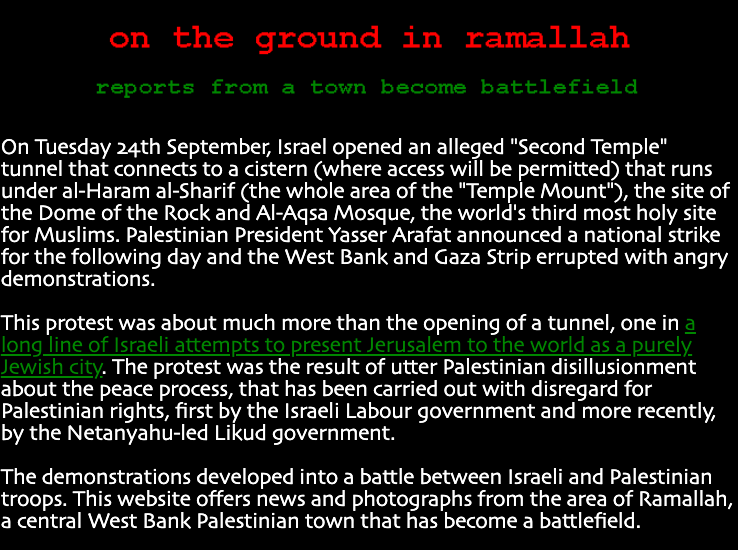
Various staff members and students began collecting content on the war—this was the first Palestinian/Palestinian Authority-Israeli face-to-face armed conflict, albeit with Israeli tanks and helicopter gunships vs. some Palestinian rifles.
One of the sections of the site was the Overview of everything taking place around the country, compiled daily by Palestinian-Canadian Birzeit staff member Hanan Elmasu. I had long been researching national Palestinian statistics but this was the first time we were the ones in the position to try to keep track of casualty numbers for a sustained length of time, during absolute, exhausting chaos.
Casualty statistics compiled during wars are always undercounts
Since Israel’s latest attack on Gaza, Reuters noted on November 15th that the statistics released by the Ministry of Health in Gaza reflect an obvious undercount due to disruption caused by Israel’s assault, as did AP on November 21st.
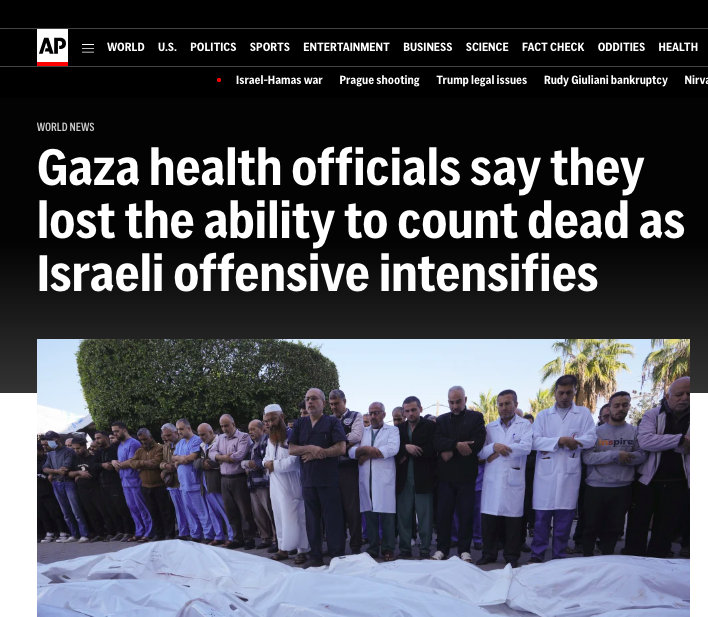
Reuters (15 November 2023)—But as Israeli forces have pushed deep into the Gaza Strip and communications infrastructure has been degraded, contact with hospitals has buckled and systematic data collection has become more problematic, the ministry said.
“For the fourth consecutive day, the ministry faces challenges in updating the number of casualties because of services and communications collapsing in hospitals in the north,” it said in a statement.
Source: https://www.reuters.com/world/middle-east/palestinian-officials-say-harder-update-gaza-casualty-toll-health-system-buckles-2023-11-15/
Casualty statistics are always sourced from local hospitals and morgues—no matter who is in power
Whether we lived under direct Israeli occupation or in the Oslo period when the Palestinian Authority Ministry of Health was created, the places that everyone got their casualty statistics from remained the same—local hospitals and morgues. That seems an obvious thing to state, when you look at this statement, but now consider the popular “HAMAS Ministry of Health” delegitimization phrase coined to cast doubt on the numbers of Palestinians Israel is killing daily. It needs to be said.
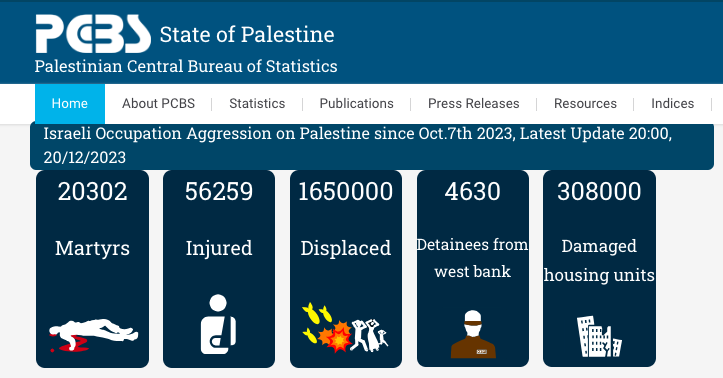
Figures are always locally sourced from reports by hospitals and morgues around the country and aggregated directly and independently by a variety of organizations—including the United Nations Office for the Coordination of Humanitarian Affairs and other divisions of the UN, which runs much of the medical and refugee service infrastructure on the ground, the Palestinian Red Crescent Society (the Red Cross in the Middle East), the Palestinian Central Bureau of Statistics, and human rights documentation agencies such as the Palestinian Center for Human Rights in Gaza.
A list of resources for casualty statistics can be found on the Casualty & Other Statistics from Israel’s War on Gaza special section on this site.
Just one example during the current conflict in Gaza is the World Health Organization’s oPT Country Dashboard, sourced from 52 partners including: 18 international NGOs, 17 Palestinian NGOs, 7 UN agencies, 1 national authorities, 4 WHO donors, and 5 organizations with observer status.
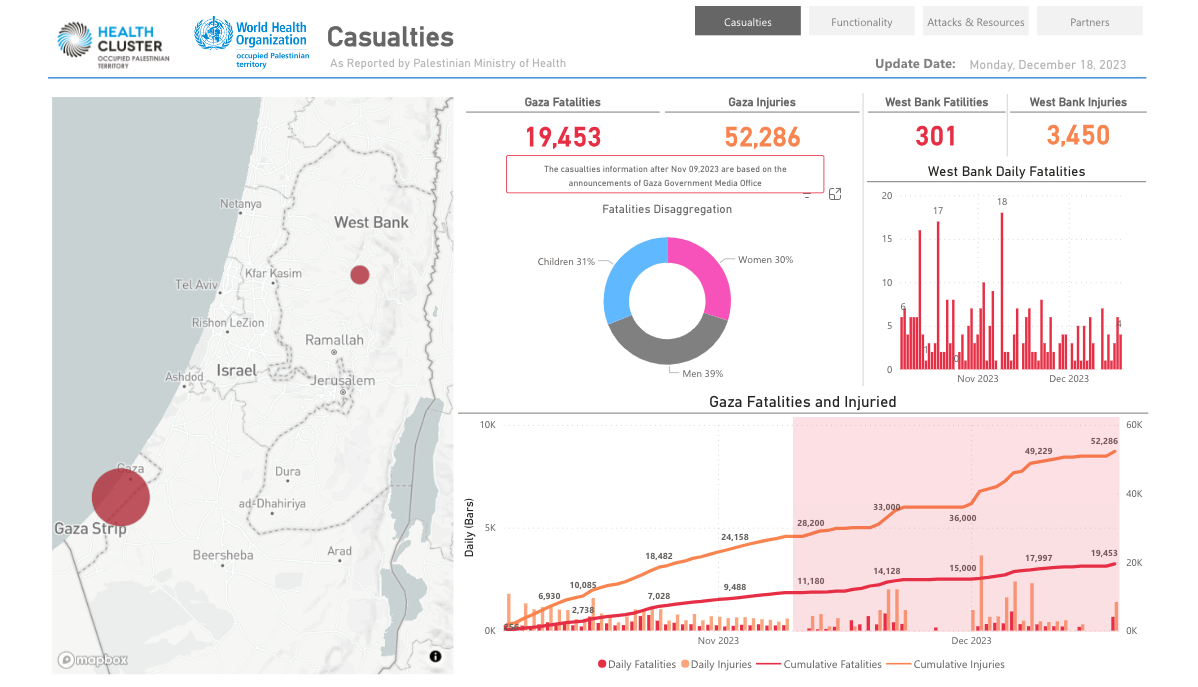
The dashboard is “updated daily or as often as data is received and validated.” Find it halfway down the page at https://healthcluster.who.int/countries-and-regions/occupied-palestinian-territory
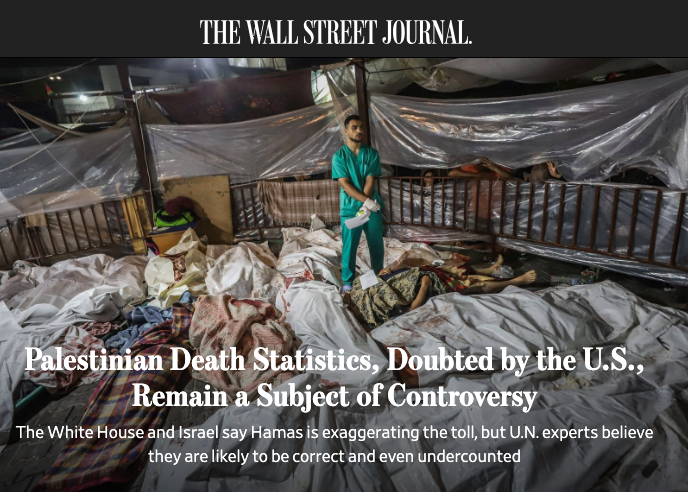
The collection process is transparent and the same hospitals and morgues are still the sources for the statistics of the “HAMAS Health Ministry” as the Israelis and their supporters are fond of calling it—as asinine as dubbing the U.S. Department of Health and Human Services the “Democratic Department of Health and Human Services” or the “Republican Department of Health and Human Services”, depending on which party happens to be in power.
Some things remain the same, no matter what country you are in or what government is in power because—in the end you always have to get your death and injury stats from the same damn place—from the people who deal directly with the dead and injured.
Independent reviews of official Palestinian casualty statistics
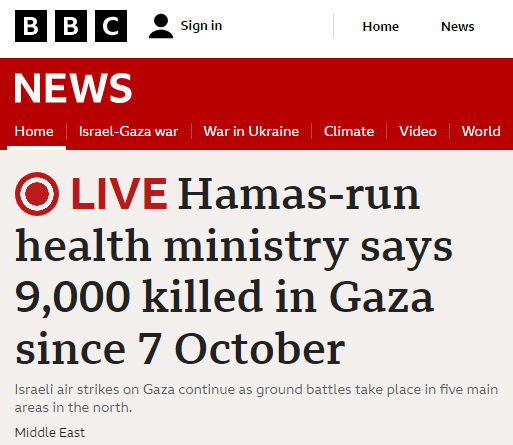
With Israel’s routine dismissal of Palestinian death and injury statistics, international media casting doubt by politicizing their sources, (see right) and international humanitarian organizations needing to know how scale their responses, multiple independent reviews of Palestinian casualty statistics have been conducted throughout the years. They always conclude the same—that, given a small margin of acceptable error of a percent or two—they are accurate.
In an October 26 article in the Guardian, Chris McGreal cited Human Rights Watch’s Israel and Palestine director, Omar Shakir, who comes to the same conclusion I have reached, after closely watching Palestinian casualty statistics since 1994:
Omar Shakir, the Israel and Palestine director at Human Rights Watch, said he saw no evidence that the numbers were being manipulated.
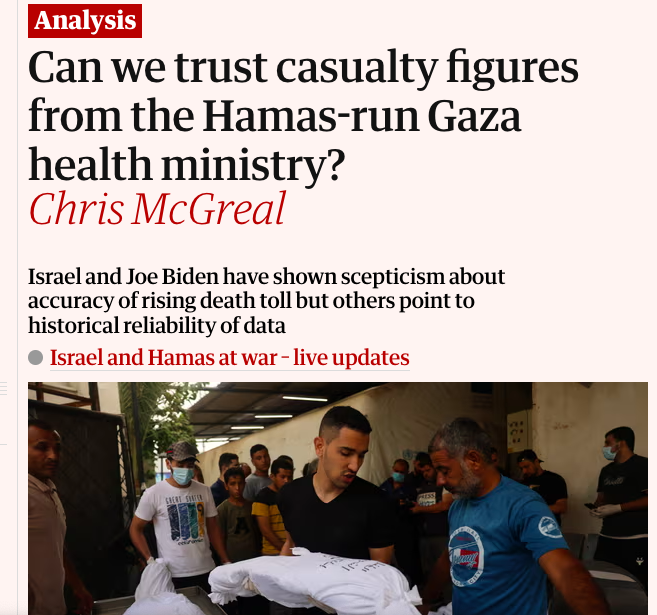
“We have been monitoring human rights abuses in the Gaza Strip for three decades, including several rounds of hostilities. We’ve generally found the data that comes out of the ministry of health to be reliable,” he said.
“When we have done our own independent investigations around particular strikes, and we’ve compared those figures against those from the health ministry, there haven’t been major deviations.
“Their numbers generally are consistent with what we’re seeing on the ground in recent days. There have been hundreds of airstrikes per day in one of the most densely populated areas of the world.
“We’ve looked at satellite imagery. We’ve seen the number of buildings, and the numbers that are coming out are in line with what we would expect with what we’re seeing on the ground. So you put all those things together and we’re quite confident in the overall casualty numbers.”
Shakir said a grey area was differentiating combatants from civilians among the dead, but the large proportion of women and children killed was indicative of high civilian casualties. He also said there was a need to draw a distinction between the immediate casualty numbers that came out quickly on any given day and those compiled over time, when there was more clarity.
On October 31st, a Voice of America report, “Is Gaza’s Health Ministry Trustworthy?”, quoted Palestinian prime minister, Mohammad Shtayyeh:
Palestinian Authority Prime Minister Mohammad Shtayyeh hit back against the U.S. in an interview with Al Jazeera last Thursday, referring indirectly to Biden and other detractors.
“There are certain leaders who don’t want to see reality,” he said. “The numbers are correct. They are our numbers. These numbers are fed to us from the hospitals of Gaza every single day that are received by our Ministry of Health.”
On November 6th, PBS quoted a WHO official:
“The numbers may not be perfectly accurate on a minute-to-minute basis,” said Michael Ryan, of the World Health Organization’s Health Emergencies Program. “But they largely reflect the level of death and injury.””
Researchers, academics, and conflict veterans have examined the casualty statistics from Israel’s current war on Gaza
On 26 November and 6 December 2023, The Lancet, one of the oldest and most prestigious medical journals in the world, published two articles about the casualty statistics coming out of Israel’s current war on Gaza. Like other reputable scientific journals, The Lancet employs a rigorous peer-review process. This means that submitted manuscripts undergo evaluation by experts in the field before publication to ensure quality and accuracy.

The first article it published, on 26 November 2023, was titled “Excess mortality in Gaza: Oct 7–26, 2023”, written by London School of Hygiene & Tropical Medicine faculty members. The authors were Faculty of Epidemiology and Population Health professor Zeina Jamaluddine, Francesco Checchi who has worked with Médecins Sans Frontières and the World Health Organization, and Oona M R Campbell, who has worked with the World Health Organization, UNICEF, USAID, and many other international foundations and government health ministries.
The authors concluded:
Our simple analysis indicates high excess mortality among Gazan population groups that are likely to be largely civilian, including humanitarian and health-care workers, indicating a substantial number of Palestinians killed during this period. Assessments of Palestinian MoH data validity in the 2014 conflict had shown them to be accurate, and we saw no obvious reason to doubt the validity of the data between Oct 7 and Oct 26, 2023.
Source: https://www.thelancet.com/journals/lancet/article/PIIS0140-6736(23)02640-5/fulltext
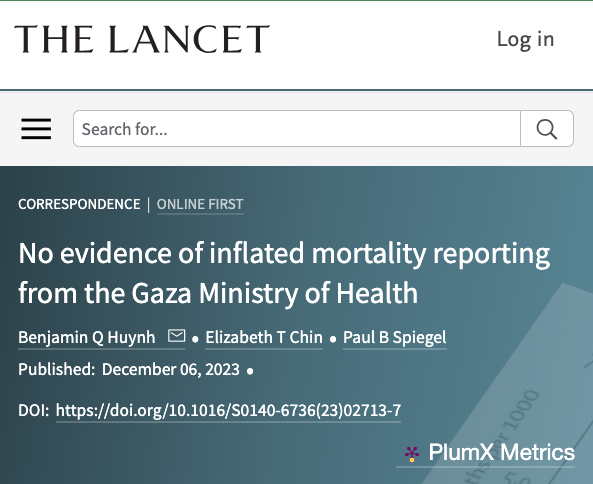
The second article published on 6 December 2023 by The Lancet, was titled “No evidence of inflated mortality reporting from the Gaza Ministry of Health” written by faculty members from the Department of Environmental Health and Engineering in the Johns Hopkins Bloomberg School of Public Health including Ben Huỳnh, a former data scientist for the World Health Organization and Médecins Sans Frontières, Biostatistics professor Elizabeth Chin, and Paul B Spiegel, recognized for his research on preventing and responding to complex humanitarian emergencies and director of the Center for Humanitarian Health.
The authors noted that:
The Gaza MoH has historically reported accurate mortality data, with discrepancies between MoH reporting and independent United Nations analyses ranging from 1·5% to 3·8% in previous conflicts.
Using publicly available information, we compared the Gaza MoH’s mortality reports with a separate source of mortality reporting and found no evidence of inflated rates. We conducted a temporal analysis of cumulative-reported mortality within Gaza for deaths of Gazans as reported by the MoH and reported staff member deaths from the United Nations Relief and Works Agency for Palestine Refugees in the Near East (UNRWA), from Oct 7 to Nov 10, 2023. These two data sources used independent methods of mortality verification, enabling assessment of reporting consistency.
Source: https://www.thelancet.com/journals/lancet/article/PIIS0140-6736(23)02713-7/fulltext
“The Science Is Clear. Over 30,000 People Have Died in Gaza”

On 15 March 2024, TIME magazine published an article by Lee Roberts, titled “The Science Is Clear. Over 30,000 People Have Died in Gaza” that examines the methodology of both Lancet articles.
Les Roberts is an Epidemiologist and Professor Emeritus at the Columbia University Mailman School of Public Health. He has taken part in the field measurement of mortality in crises including: Rwanda 1994, more than 30 health Zones in the Democratic Repoublic of Congo 1999-2002, Iraq 2004, Zimbabwe 2007, the Central African Repbulic 2009, 2018, and 2022, and Sierra Leone 2000 and 2014.
Les Roberts concludes:
There are certain building blocks of society that require agreement for us to work well collectively. Society is weaker and discourse less productive if we cannot agree on at least a few basic things. In the case of Gaza, acknowledging that there was an appalling and extremely deadly attack on October 7th, and that over 30,000 Gazans have died since, mostly women and children, seems like the most basic of cornerstones of reality on which to move toward constructive discussion and eventual resolution.
Source: https://time.com/6909636/gaza-death-toll/
Israel itself accepts and uses the Gaza Health Ministry casualty numbers
On 24 January 2024, 972 Magazine journalist Yuval Abraham posted the following on Twitter, linking to an article in Hebrew on Local Call:
Israeli intelligence secretly surveilled officials in Gaza’s Health Ministry to check if their data on the number of civilians killed in Gaza is ‘reliable’, Israeli intelligence sources told us.
The army found the numbers are reliable and now regularly uses them internally in intelligence briefings.
According to two sources, Israeli intelligence has no good independent measure of the total number of civilians the army killed in Gaza, making the Health Ministry’s data their main source of information.
One reason for this is that officers conducted hundreds of AI-directed assassination strikes against suspected low-level Hamas operatives, usually by destroying entire homes and killing entire families – a practice we previously termed a ‘mass assassination factory’. There was often no bomb damage assessment (BDA) for these strikes, meaning there was no check on who and how many civilians were killed. This routine post-strike check was skipped to ‘save time’.
‘I don’t know how many people I killed as collateral damage. We only check that information for senior Hamas targets,’ one source said. ‘In other cases I didn’t care. I immediately moved on to the next target. The focus was on creating as many targets as quickly as possible. That’s why I trust the Health Ministry in Gaza more than the IDF for these statistics. The army just doesn’t have the information.’
Source: https://twitter.com/yuval_abraham/status/1750123648533324158
Why Israel delegitimizes Palestinian casualty statistics even though it knows they are accurate
Israel and its genocide assistants in Western countries claim the Palestinian casualty numbers are exaggerated, and that civilian casualties are the natural product of war because they know very well that Israel is doing something wrong, committing war crimes, in danger of being found guilty in the case that South Africa brought to the International Court of Justice against Israel, for its violations of the Genocide Convention.
The downplaying of numbers is used as one of the tools by which Israel can claim “no genocidal intent”, the old ‘collateral damage’ excuse that is every carpet bomber’s excuse.
Here’s White House spokesperson John Kirby modeling the tactic:
One side is definitely ‘lying about its numbers’!
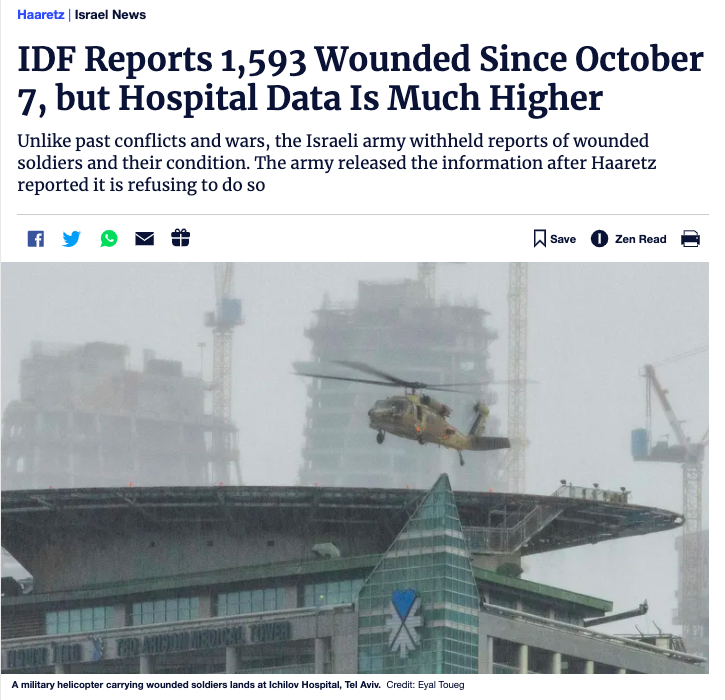
One side is definitely “lying about its numbers”—Israel. Obviously Israel is publicly minimizing the scale of death and injury of Palestinians it is killing but there is evidence that it also minimizes the number of its own soldiers who are wounded—in both cases to avoid reaping public protest.
A 10 December 2023 article in Israel’s Ha’aretz newspaper titled “IDF Reports 1,593 Wounded Since October 7, but Hospital Data Is Much Higher” reported:
Making its first such announcement since Hamas attacked on October 7, Israel stated on Sunday [Dec 10] that 1,593 Israeli soldiers have been wounded during this period.
The gaps between the army’s data and the hospitals’ data also comes into sharp relief in light of Health Ministry statistics maintained on its website. This website displays general casualty data – civilians and soldiers alike. According to the Health Ministry’s data, 10,548 soldiers and civilians who were wounded in the war have been admitted between October 7 and December 10. Of those, 131 in hospital, 471 were admitted in severe or critical condition, while 868 were listed in moderate condition.
Additionally, 8,308 suffered minor injuries, 600 suffered anxiety attacks, and the condition of 206 is unknown. The army’s figure of 1,593 wounded soldiers accounts for only 15 percent of the total number of [hospital] admissions, which seems unusually low, since one would expect a significant portion of the war-related casualties to be soldiers.
Source: Ha’aretz
Statistical Sources and Discussions of Casualty Statistics
On this website, see the special section Casualty & Other Statistics from Israel’s War on Gaza for statistical sources of casualty data, overviews of methodology, media investigations, aid agency reports, and academic studies about Palestinian casualty statistics.
Article published 22 December 2023, last updated 26 March 2024.

Scottish OG from the time of the First Intifada and the birth of the international movement of solidarity with the Palestinian people • Former Friends of Birzeit University Coordinator • Birzeit University Public Relations Officer • Cofounder and Editor of the original Electronic Intifada website • Creator of countless websites for pro-Palestinian organizations around the world via nigelparry.net


